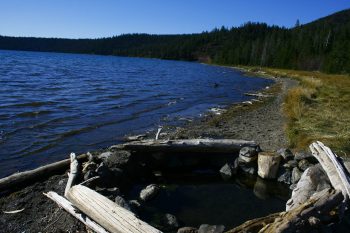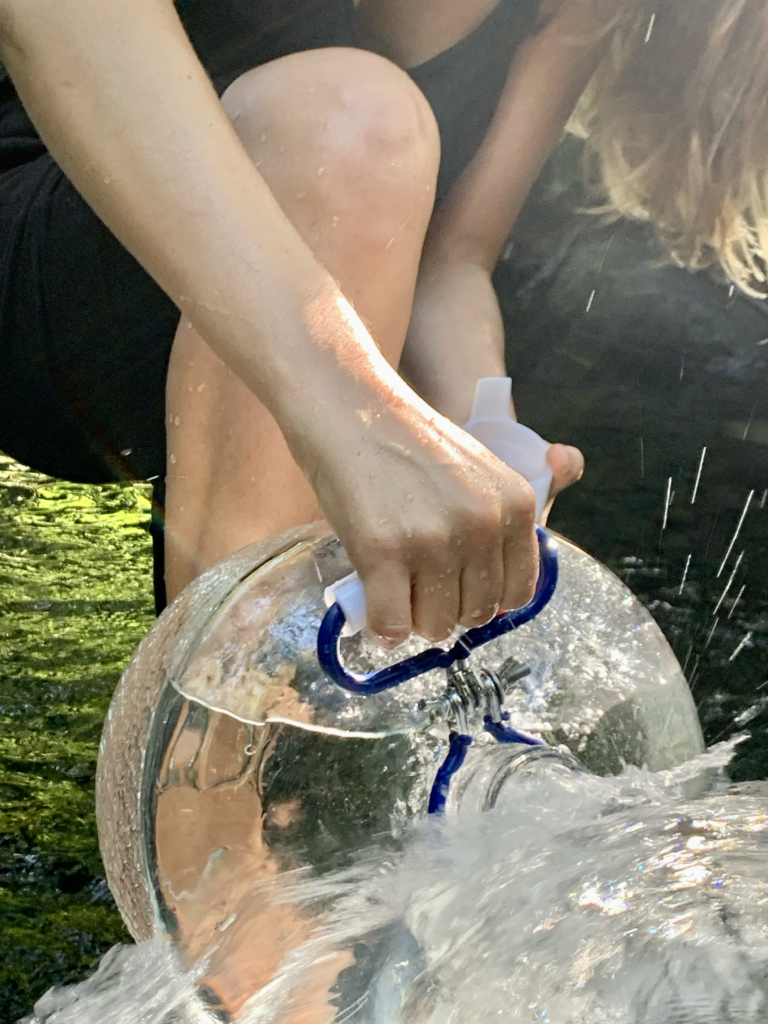Paulina Lake Hot Springs Near Bend, OR
Paulina Lake Hot Springs is a non-commercial hot springs located near the Newbury Volcanic Monument in the Deschutes National Forest. The hot pools at Paulina Lake are primitive, to say the least – typically featuring circular dugouts within the sandy banks of the lake where some pools are bordered with rocks and wood.
The hot springs pools are located in an area of Paulina Lake known as Hot Springs Beach and are accessible either through the Paulina Lake Hot Spring Trail, the Hot Springs Spur Trail or by kayaking or boating Paulina Lake. The relatively remote location of the hot pools result in limited visitors and is a perfect place to escape to and relax when visiting the Deschutes National Park.
Paulina Lake Hot Springs Pool Information
The Paulina Lake Hot Springs complex include five geothermal pools situated within the sandy banks of Paulina Lake Beach. The hot springs pools are relatively small and typically accommodate one person per pool. The water temperature ranges from 90 to115 degrees Fahrenheit depending on the time of year.
Seasonal Access Information
For the best experience, consider visiting Paulina Lake Hot Springs between May and July. During other months, the hot springs are fully submerged under Paulina Lake.
Hiking to Paulina Lake Hot Springs
You can reach Paulina Lake Hot Springs from either the Paulina Lake Hot Springs Trail or the Hot Spur Spring Trail. The Paulina Lake Hot Springs Trail is the longer route covering over 7.5 miles around the picturesque Paulina Lake loop. This hike is perfect for experiencing more of the natural beauty of the Deschutes National Park and also ideal for those wanting a more challenging hiking option. The Hot Spur Trail is the quickest way to get to the Paulina Hot Springs; it is a 1.2 mile hike across the eastern shores of the Paulina Lake with extremely limited elevation.
Camping Information
Paulina Lake Hot Springs is located within the Deschutes National Forest, and there are camping areas relatively close to the Hot Springs if you choose to stay overnight and experience as much of the natural beauty of the volcanic area as possible. The Paulina Lake and Little Crater Campgrounds are excellent options for those interested in hot springing.
The Paulina Lake Campground is located on the south shore of the Lake and includes amenities such as potable water and restrooms. The cost to stay overnight at this campground is $18 per night for one RV and an additional $9 per if you are adding a second RV. For a Dump Station, the nightly rate is $10. The Day use fee for the Paulina Lake Campground is $10. It is recommended that you make prior reservations for this campsite. Paulina Lake Campground is open between May and October.
The Little Crater Campground includes 49 camping sites and is found almost at the edge of Paulina Lake. The Campsites here can accommodate RV’s, trailers and tents and potable water and flush toilet facilities are available. This campground is available between May and October. The cost for an overnight stay at Little Crater Campground is $18, an additional $9 is charged for a second RV and the Day use fee is $10.
There are also a handful of backcountry campsites available at North Cove Beach, which is about 1 mile west of North Beach.
History of Paulina Lake Hot Springs
Paulina Lake Hot Springs was developed after the collapse of the Newbury Volcano core and the resulting crater filling with water. Continued lava flow throughout many years resulted in the separation of the crater into two bodies of water – Paulina Lake and East Lake along with the development of hot springs on the beach of Paulina Lake.
Paulina Lake Hot Springs Soak Stats:
Season: Spring, Summer, Fall (access road often closed during winter)
Type: Hike (1.2-7.5 miles depending on which trail)
GPS: 43.719 121.209
Map Quad: CRESCENT
Elevation: 6,340 ft
Land: Public – Deschutes National Forest
Fee: None
Restrictions: No camping allowed at North Beach
Usage: High
Visibility: Moderate
Temp: 90-115
Water Clarity: Moderate
Odor: n/a
pH: n/a
Area Features: Newbury Volcanic Monument
Closest Food/Gas: Paulina Lake
Trash: Moderate
Bugs: Moderate
Wildlife: Moderate
Camping: Paulina Lake Campground, Little Crater Campground, North Cove Beach (primitive sites)
Clothing Optional: n/a
Pit Toilet: No




Responses